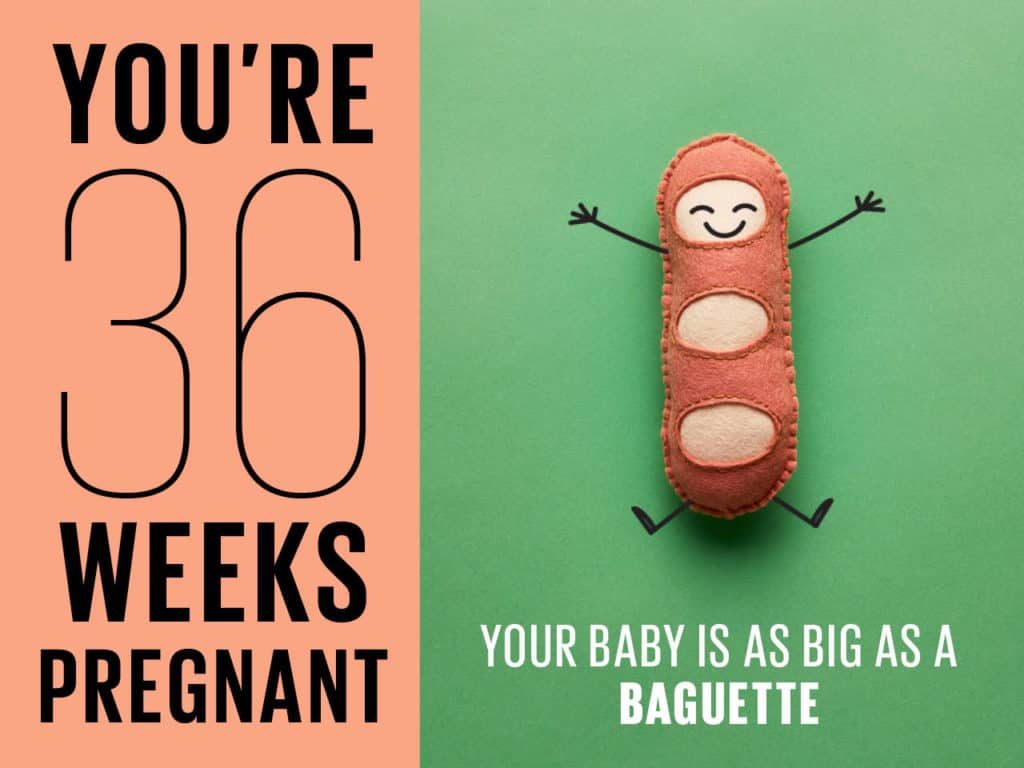
The 36 weeks pregnant is when mothers are in their last stretch of giving birth and when the baby ‘drops.’ This is also the time when you will begin to experience what is known as the ‘classic pregnancy waddle.’ Your baby, in the 36th week of pregnancy, will measure approximate 18.7 inches long and weigh an impressive 5.8 pounds. To put this in perspective, that would be about the size of a larger-than-average cabbage. There’s a lot more to discuss if you are a 36 weeks pregnant mama. So, let’s get to it.
How Much is 36 Weeks Pregnant in Months?
At 36 weeks pregnant, you are approximately 8 months and nearing the end of your 9-month pregnancy. Pregnancy is typically considered to last for about 40 weeks, divided into three trimesters.
So what else is happening to your baby in the 36th week of pregnancy?
In the 36 weeks pregnant, the baby changes its position and transitions to the ‘head down’ position favorable for a baby’s birth. Here’s what else is happening to the baby in the 36th week of pregnancy-
1. Baby drops
You might have heard this term too often but still might not be as sure what that means. When the baby drops, it essentially means that the baby moves down into your pelvic region so as to get ready for birth (more about this later)!
2. Blood starts to circulate
The baby’s blood circulation system has fully developed.
3. Baby starts to shed
All babies have a varnish-like layer of protection on their bodies called vernix caseosa. This layer of protection as well as the baby’s downy hair starts to shed in the 36th week.
4. Skull and Bones
At 36 weeks pregnant, your baby’s skull bones are not fully fused, allowing for easier passage through the birth canal. This flexibility extends to most of the baby’s bones and cartilage, facilitating delivery. These structures will gradually harden over the first few years of the baby’s life.
5. Baby’s Digestion is Not Matured Yet
At 36 weeks, most of your baby’s systems are mature for life outside the womb, including circulation and the immune system. However, the digestive system is still in the process of maturing, as it has been inactive during gestation when the baby relied on the umbilical cord for nutrition. It will take the first year or two after birth for the digestive system to fully develop and become functional.
Baby ‘Drop’ - What happens when a baby ‘drops’?
Baby ‘dropping,’ also known as lightning, is one of the most prominent signs of approaching labor. As a part of this process, by the 36th week of pregnancy, the baby “drops” lower into the mother’s pelvis and engages within the mother’s pubic bones. Though this happens, in most cases, around the 36th week, in some babies it can never happen in the 37th or the 38th week. Lightning could also be referred to as a sign from the baby that they are all set to give birth!
So does lightening or baby ‘drop’ mean labor is approaching?
While lightning is a major sign that labor is on the way, it should be noted that it is not always 100% imminent. Some mothers might still take a couple of weeks before going into active labor. Moms who have already had babies in the past, in particular, might experience the baby drop right before they go into labor.
How to determine if a baby has dropped during pregnancy?
While in some cases the mothers might feel an obvious change to help them understand the baby has dropped, some mothers might hardly feel anything.
Here are a few signs that suggest your baby might have dropped-
1. The breathing becomes more relaxed
You may have been breathing uneasily for a long time and now, suddenly, you might feel that your breathing has become rather relaxed as a result of the baby dropping. It happens after dropping the baby makes a home in the uterus, causing lesser pressure on the diaphragm, resulting in easier breathing.
2. Waddled walk
Hello penguin mamma! Once the baby drops, they change their living quarters, move to the pelvic region and so, your hips spread a bit to accommodate the baby. As a result of this, you might notice that your walk has started to waddle. Also, you may experience that as a 36 Weeks Pregnant has pelvic pain and it hurts to walk.
3. Increased urination
Since your baby is now in the pelvis, you would feel some extra pressure on your bladder via their head, resulting in increased trips to the loo.
4. Lesser heartburns
Once a baby drops, there isn’t as much pressure on the uterus from the stomach and hence, you would begin to experience lesser heartburns. With less heartburn, your appetite will likely get better too.
5. Lower bump
Since the baby now sits lower in the pelvic region, your pregnancy bump might also appear to have lowered.
What happens to a mother’s body in the 36th week of pregnancy?
The 36th week of pregnancy sure is the final stretch, but again, it will not be free of symptoms and bodily changes. Here’s what is happening to a mother’s body in the 36th week of pregnancy-
1. Pelvic aches and pains
Once the baby has dropped, it puts more pressure on the pelvis, causing you to experience what is technically called “pelvic girdle pain.” Submerging your body in a pool or a bathtub could help alleviate some of this discomfort
2. Vaginal discharge
You might argue that the discharge has been a part of your pregnancy anyway but hear us out! Your vaginal discharge will more likely increase and you need to now keep an eye out for any unusual-looking fluid. Reach out to your doctor immediately especially if you see any hint of blood or a watery discharge. The blood-tinged fluid could be your mucus plug which is commonly lost only in the 37th week (and means approaching labor), while the watery fluid could be your amniotic fluid. While this is not a big deal, keeping your doctor in the loop is always recommended.
3. Change in walk
As discussed earlier, the classic mother waddle should spoon be experienced after the baby drops. Also, 36 Weeks Pregnant has pelvic pain and it hurts to walk.
4. Troubled sleeping
Since your belly will be definitely big by the 36th week, you might feel uncomfortable and might also have to deal with various kinds of pains and definitely get 36 Weeks of pregnant cramps. While this is definitely an annoying situation to be in, you could also look at it as nature’s way to prepare for countless upcoming so-so-sleep nights after the baby arrives!
5. Heartburn or Indigestion
The pressure from your expanding uterus may reduce your appetite during meals, but this can be advantageous. Smaller meals are beneficial for your digestive system and may contribute to the control of heartburn.
6. Bloating or Gas
In addition to heartburn, you may be experiencing increased bloating, gas, and burping during pregnancy. Choosing smaller meals can help alleviate heartburn, and avoiding rushed eating can reduce the intake of excess air, potentially easing bloating and gas discomfort. These symptoms are temporary and likely to subside.
7. Itchy Belly
If your belly feels stretched and itchy, consider using creams with cocoa butter or vitamin E for relief. These products can soothe the discomfort associated with skin stretching during pregnancy. Additionally, involving your partner in applying the cream not only provides relief but also creates a bonding opportunity with the baby underneath.
What does a 36-week pregnant belly look like?
To put this in rather plain words – by the 36th week of pregnancy, there wouldn’t be much difference between you walking your belly and your belly walking you! You would have also gained as much as 25-35 pounds by now and you might be getting sick of all the extra weight around your stomach; but as we said- just a little bit longer mamma dearest!
36 Weeks of Pregnant Symptoms Not to Ignore
Important signs to address when you’re at 36 weeks of pregnancy:
- If you’re concerned about reduced fetal movement.
- Persistent headaches or visual disturbances.
- Unusual swelling in your feet, hands, ankles, or face.
- Experiencing vaginal bleeding.
- Noticing an unusual colored discharge.
- Suspecting that your amniotic sac has ruptured.
- Extreme abdominal pain or frequent, painful contractions.
- If you have a temperature, chest pain, or difficulty breathing
- Swollen or hot calves.
These are the 36 weeks pregnant symptoms not to ignore. It is crucial to consult with your healthcare professional if you encounter any of these symptoms.
Final Takeaway
These are the final weeks of your pregnancy and your baby will be out in the open sooner than you know! Some mothers might as well feel rather overwhelmed at this point of pregnancy but worry not, you are never alone in this! This might also be a good time to catch up with your friends before the baby arrives and your uninterrupted gossip sessions go for a toss. The 36th week could also be a good time to indulge in some pregnancy exercises as your body is working very hard internally to prepare you for the delivery.
Over and above everything else, this is the time to think ahead, to pause unnecessary commitments and to just give yourself and the life within you the kind of love and care it deserves!










